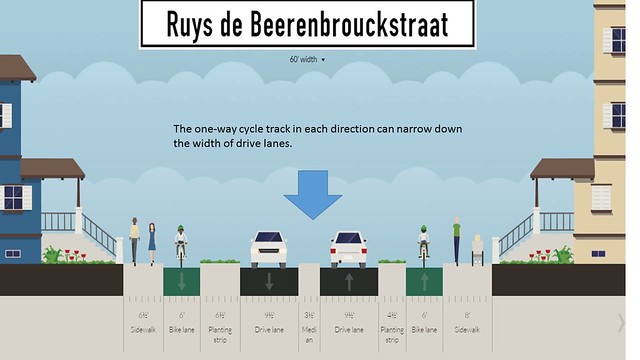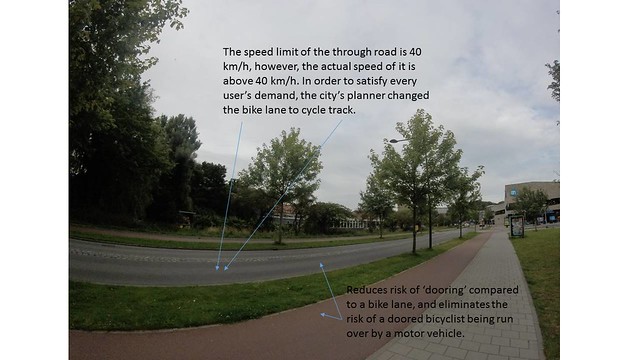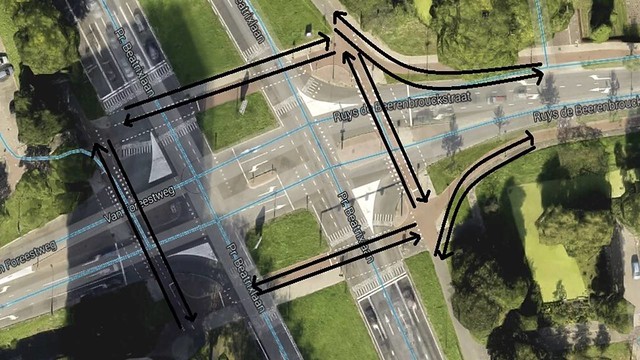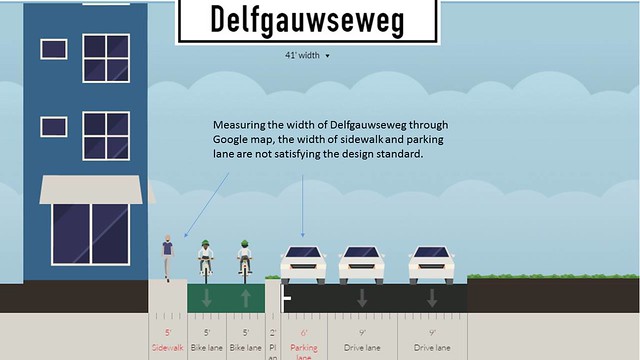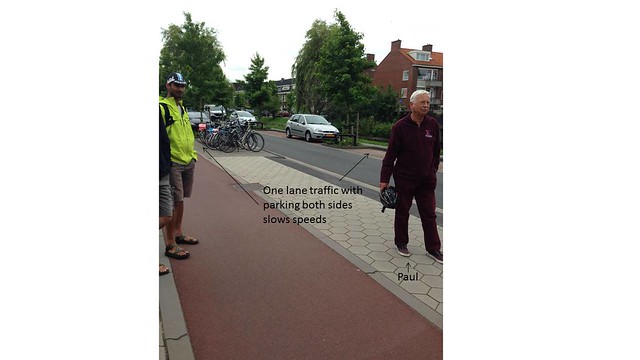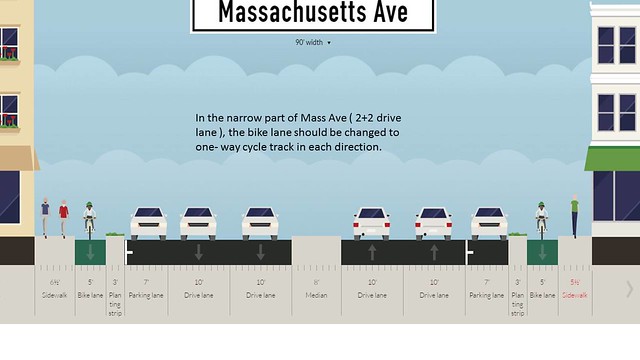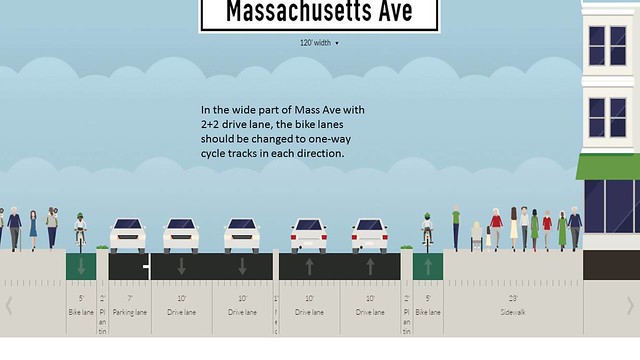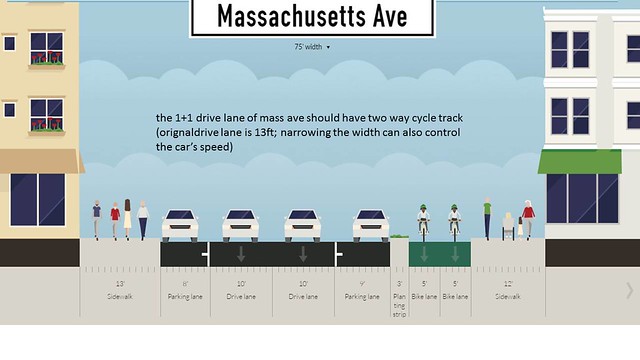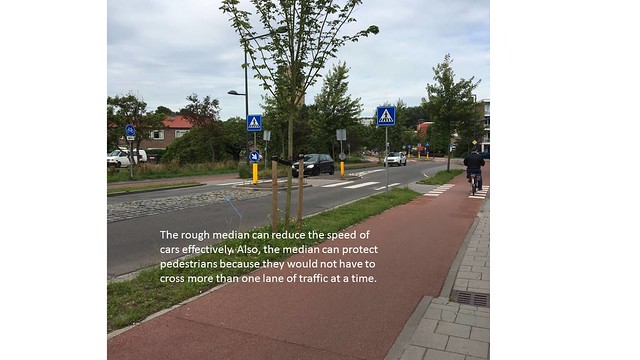Topic 4. Retrofitting to get protected bike lanes.
Introduction
During the period 1998-2014, both Delfgauwseweg and Ruys de Beerenbrouckstraat were converted from having regular bike lanes to having a two way cycle track and two one way cycle tracks, respectively. Cycle tracks are like bike lanes, except they have some vertical grade and horizontal separation for car traffic. So with the two-day bike tours and professor’s interpretation, my partner and I decide to explore the reason why they were changed to the cycle tracks, and the different factors that led to the different choice for one-way cycle track and two-way cycle tracks. Meanwhile, nowadays the development of the bicycle in the United States is booming, so with the deep study of cycle track , we also choose a street in the US to practice and recommend the accompanying treatments with cycle tracks.
Section 1. Ruys de Beerenbrouckstraat
1.1 The reason for changing
The main issue on Ruys de Beerenbrouckstraat was the conflict of interest between the residents on the streets and the local government. The residents had requested that the street be considered local, with slower safer speeds, and small traffic volume, because they didn’t like the fast and high traffic in front of their homes. For the local residents, it was considered dangerous, because irregular fast cars were a hazard when crossing the street. However, the Province said that they couldn’t fulfill that request, because Ruys de Beerenbrouckstraat was considered a critical east-west through way, and needed to have a smooth traffic flow for a fairly large volume of vehicles. Other east-west streets would be too far away to be convenient for drivers. Because of these interests, the new design of Ruys de Beerenbrouckstraat is shown below:
The traffic flow is the same as before, despite removing a lane from each direction of traffic, and removing two traffic lights. The lights were replaced with raised crossings, which along with medians, chicanes, and narrower lanes, slowed traffic. This slowed average speed on the road. But it didn’t reduce volume. There were still many cars passing through the street, and at a fairly consistent speed. The extra space from each removed lane of traffic was able to supply sufficient space for cycle tracks to replace the previous bike lanes. Where the city might have had the choice to widen the sidewalks or keep the bike lanes, they didn’t, because cycle tracks made the most sense here. The mostly residential streets didn’t need very wide sidewalks. And they were already enough to have two people walking side by side. Cyclists wouldn’t want to ride close to large volumes of traffic or parking spots, if they can avoid it. On this street, cycle tracks also made for safer intersections, because there were raised intersections with red asphalt, giving a feeling cycle track continuation in the intersection, and indicating cycle track priority. It was thus a natural transition to create cycle tracks to replace bike lanes.
1.2 The reason for one-way cycle track
And then there was the question of whether the road should contain one or two way cycle tracks. We know that with the two car lanes removed, there would be enough space for at least a one way cycle track on either side of the road. A two lane cycle track on each side may take up more space than provided, and could create more complex intersections. A two way cycle track on one side was also an option. But in this case, the one way tracks seemed most reasonable. Because the street is mostly used as a throughway, it would also be expected that much of the bicycle traffic is also a throughway. There are some shops on the street, primarily the Albert Heijn supermarket on one side of the street. On a street like this, it would be expected that most trips are destination oriented. People are either trying to just use the street as a through-way, or they are using it to get home, or get to the Albert Heijn. Unlike a street with a shopping mall, it wouldn’t be expected that people would go back and forth between locations on one side of the street, so a two lane cycle track may not have been necessary. Because the car traffic was slowed and crossings made to only cross one lane of traffic at a time, the few needed crossings for cyclists would not be very intimidating. Car-bike potential trouble areas would be when cars need to cross into local residential streets. With one way cycle tracks, drivers need to pay attention to basically one side of bike traffic (although they should always check both).
1.3 Conclusion
With one way cycle tracks
With two way cycle tracks
From an intersection standpoint, one way cycle tracks could simplify complicated crossings. This is the main intersection feeding into Ruys de Beerenbrouckstraat. Many of the crossings are two way, but fed by one way cycle tracks. If they were fed by two way cycle tracks, the crossings could get very confusing, whereas one way cycle tracks at intersections could provide more conventional crossings for motorists.
Section 2. Delfgauwseweg
2.1 The reason for changing
Delfgauwseweg was originally a street with two bicycle lanes on each side of the street, which was lined by a canal on one side and lined by local residential areas on the other. Now it has been converted to being one two-way cycle track on the residential side of the street, and no sidewalk or bike facility on the canal side of the street.
The road was not primarily used by residents. Rather, it was considered a through street, and needed to remain that way. At the same time, it would have been preferable for the residents if the traffic on the street would slow down. The street is still primarily straight, and has no speed humps or many traffic slowing mechanisms, thus indicating that the road is still able to carry a steady flow of through traffic. On a street with fairly quick paced auto traffic and residential parking spots, bike lanes would not be ideal. Thus, a cycle track was the best option to protect cyclists.
The second main constraint for the design was space. When measured on Google maps, the road is found to be quite narrow, being only around 41 ft wide. The sidewalk is necessary on the residential side of street, because people would need to exit their homes on this side. This sidewalk is 5 feet, which is around the minimal size for a sidewalk. What’s left was needed for bike facilities, residential parking, and 2 way traffic. Because a two way cycle track saves space, being around 8-12 feet with one side of buffer for parked cars, as compared to two one ways (around 5 ft) each needing a buffer, a two way cycle track was chosen for this area. A two way cycle track usually equates the size of 2 bike lanes, and so this option made sense to replace the bike lanes on a spacial level.
2.2 The reason of two-way cycle tracks
The other question was which side to place the cycle tracks. At first, the engineers wanted to place the track on the canal side, because it would mean that the bikes would have to cross fewer intersections. However, if the cycle track was on the canal side, there would be extra buffer space needed because the sidewalk and the cycle track would each need a buffer zone. Coupling the cycle track with the sidewalk saves a few feet of buffer space. It would also be more comfortable for both cyclists and pedestrians to be bordered by each other and parked cars, rather than being closer moving car traffic. Also, the cars exiting or entering the side streets would be coming from mostly residential areas, which don’t have as short a turnover rate as something like a shopping mall. The other main reason for placing the two way track on the building side of the street is because of a potential for right hook collisions. Going down Delfgauseweg, the street forks into Anna van Saksenweg, travelling north, while Delfgauseweg continues west. Here, if the cycle track was on the north side of Delfgauseweg, and cyclists were continuing west, there might be right hook collisions when cars want to turn north onto Anna van Saksenweg. If the cycle track is on the south side of Delfgauseweg, then this issue is avoided.
2.3. Conclusion
Lastly, there aren’t really any points of interests on the canal side of the road. If someone wanted to stop at one of the restaurants or businesses or homes, they would have to cross the canal side cycle track, across two lanes of traffic, which would not have been as safe.
Section 3. Other example: Rembrantkade
The last bike lane to cycle track conversion street we saw was Rembrantkade. It used to have two bike lanes and two way traffic. The speed limit for this type of street was the standard 50 kph, but because it was seen as a wide road, a resident noted how people would travel up to 80 kmph down the street.
They remedied this by creating a two way cycle track on one side of the street, a row of parking, 1+1 two directional motor traffic, then a narrow sidewalk on the canal side. We see again many of the same characteristics here as with Delfgauseweg. The main difference here is that they decided to (and were able to) add a small sidewalk on the canal side, if people wanted to walk along the water.
Section 4. Retrofitting Strategies Applied in the US
4.1 Actual use
Looking at Boston, there aren’t that many roads with bike lanes. One prominent one though, is Massachusetts Avenue, which runs for around 16 miles, right across Boston and Cambridge. It carries large volumes of through traffic across Boston, at the same time, passing through commercial streets, making it a street with multiple functions (possibly too many). It is also, according to the cityofboston.gov, one of the most dangerous streets in Boston for bikes.
4.2 Design
Massachusetts Avenue currently has a bike lane on each side. But these bike lanes offer very minimal accommodations for cyclists. They have no buffers between the bike lanes and the parking lane or the through traffic. Because the street is lined with stores, the turnover rate for parking would be expected to be pretty high, and cars need to pass over the cycling lane to either park or drop something off. If needed, cars are not usually hesitant on blocking the bike lane for a short period of time to pick someone up/drop someone off, etc. On the other side of the bike lane, traffic flows quickly, and causes a lot of traffic stress for cyclists. Because of its mixed functionality, and high traffic stress, Massachusetts Avenue would be a good street to have cycle tracks. Then comes the question of set up. We feel that, at least for a transition phase, the lanes should simply be replaced with cycle tracks, between the parked car spots and the sidewalk. The road is very wide, ranging from 90 feet to 120 feet. Roads of this size in the Netherlands are usually fitted with one way cycle tracks on each side of the street.
In the area in front of the Christian Science Center, the road would essentially be the same, except the parking lanes and bike lanes would be swapped, and some space from the wider side of the sidewalk could be taken to create medians for the cycle tracks. The sidewalk on one side is usually around 5 feet wide, and it can stay that way. The sidewalk on the other end is extremely wide, and can be cut down to provide for the cycle tracks. These cycle tracks would most likely be one way. It’s the most logical transition from the current road set up. There could be space in this segment for two two-way cycle tracks, which would be ideal for cyclists, but it would also complicate already complex intersections for drivers. Because of the through way function of Mass Ave, it could probably stay 2+2 at this section for motor traffic because the traffic can get backed up. Also because too many changes (like removing a lane) could cause an outrage for people, such as those who commute this road daily, and feel that the road needs two lanes in each direction for steady flow. Eventually, it could be possible to make Mass Ave consistently 1+1 or 1+1+1 when needed. I don’t know yet what kind of traffic flows at different points, but I do know that it has points that flow smoothly even with 1+1 traffic, meaning the entire road should be able to function with only two lanes of through traffic.
In the narrower parts, such as after the bridge and into Cambridge/MIT area, near Hancock street, the traffic turns to 1+1 traffic with one bike lane on one side. In an area like this, the road can stay 1+1, but some of the space from sidewalks or motor lanes could be used to make the one bike lane into a two way cycle track. Although these may not be the best options for bikers, it would work as an acceptable transition phase. The other option would be to create two one way cycle tracks, to continue the cycle tracks from the wider parts of the road on the other side of the bridge. Because the area here is a school area, narrowing the lanes to add to cycle tracks may be possible. These options would also be good for transition because they require the least amount of money and road modification. For intersections, the best option might be lights, for all modes of traffic, with more measured cycle times. That is simply because yielding would be difficult with so many lanes of traffic in areas.
4.3. Intended use
These have some examples can provide the dutch’s perspective of protect treatments.
- Eliminates risk and fear of collisions when vehicles want to turn left or right.
- The wisdom use of median islands.
These shorten crossings for pedestrians, and also make the crossings safer, by only requiring pedestrians to look out for one direction of traffic at once. The crossing island also makes narrower roads at the the crossing, forcing cars to turn slightly and slow down.

